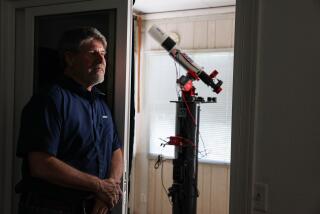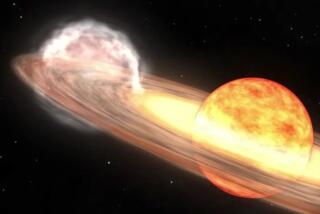Fireball in space: Astronomers capture images of a star going nova
- Share via
You don’t see this every day. For the first time, astronomers have captured images of a nova very soon after the stellar explosion flared into existence and have tracked the fireball’s dramatic expansion into space.
The discovery, described in the journal Nature, offers a unique look at a nova in action, and could give us a much more complex picture of how these explosions occur.
Novae are the result of a little interstellar teamwork between two gravitationally bound stars: a small white dwarf and its larger nearby companion. White dwarfs are older, more “evolved” stars that are packing the mass of the sun into an Earth-sized body. This tiny, dense star can leech hydrogen from its companion star, accumulating a rising “ocean” of hydrogen on its surface. When that ocean is roughly 650 feet deep, the pressure becomes too much, and the star’s surface essentially becomes a gigantic thermonuclear bomb that shoots a fireball into space.
Unlike the explosion known as a supernova, which typically signals the dramatic and violent death of a star, a nova isn’t necessarily a one-time deal; it can happen over and over again. Because it’s hard to know when one will suddenly appear, scientists had yet to get a close-up near the start of the phenomenon.
That changed on Aug. 14, 2013, when Japanese amateur astronomer Koichi Itagaki detected an object that was dubbed Nova Delphinus 2013 – a nova that had just flashed into existence hours before.
“It’s mostly luck of the draw,” said study lead author Gail Schaefer, an astronomer at Georgia State University who is based at Mt. Wilson Observatory in the Angeles National Forest. “If the person who detected the nova initially hadn’t been looking at that part of the sky, maybe weeks would have gone by.”
The scientists took advantage of the lucky break. Within 15 hours of Itagaki’s discovery and 24 hours of the nova’s appearance, astronomers working at Mt. Wilson sprang into action, putting aside their planned projects to focus on the strange new object in the sky.
Using the Center for High Angular Resolution Astronomy array, which consists of six 1-meter telescopes, the researchers collected enough data to reconstruct images on three nights in the first week of observations. They also watched the nova expand for a total of 27 nights over two months.
The nova, which the astronomers found was sitting 14,800 light-years away, quickly grew in size. When they observed it for the first time on Aug. 15, it was the size of Earth’s orbit. Two days later, it had expanded to the size of Mars’ orbit, and to Jupiter’s orbit within two weeks of detonation. By Day 43, the nova had stretched as far as Neptune’s orbit, the most distant planet in our solar system’s lineup – marking a roughly twentyfold jump from the initial observed size.
Strangely enough, the nova wasn’t quite spherical. It was 13% longer than wide – which hints at complex processes happening on the surface of the star.
“At first it kind of puzzled us because it didn’t appear to expand uniformly,” Schaefer said. Old remnants of novae are often asymmetrical, because they’ve interacted with dust and debris as they expand over long stretches of time. But this asymmetry was clearly manifesting soon after the nova’s birth.
“The fact that we see it two days after shows that the explosion itself is not symmetric – which gives you clues about how material is being ejected from the surface of the white dwarf,” Schaefer said.
This particular white dwarf might once again erupt – but perhaps not in our lifetime. Still, Schaefer said she and other astronomers would be keeping their eyes peeled for the next nova that pops off above the Northern Hemisphere.
Star-struck? Follow @aminawrite for more science news that’s out of this world.







